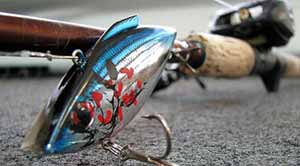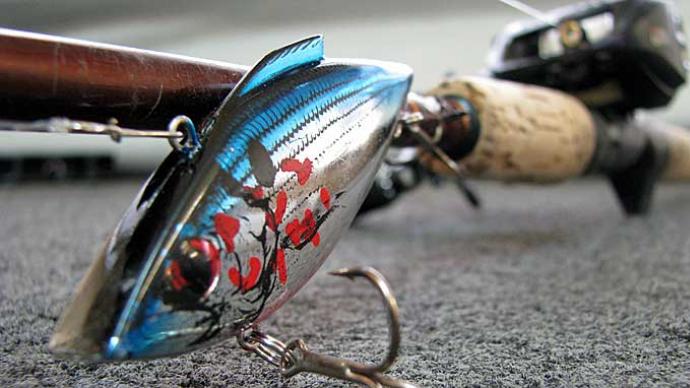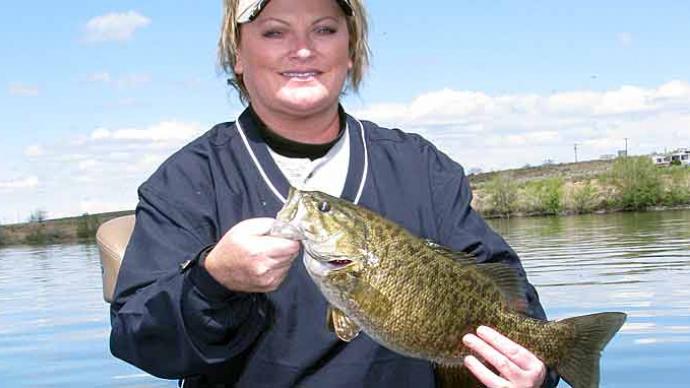
In our ongoing quest to find new and improved ways to catch more bass, sometimes the answer is right before our eyes. So often the most effective means of boating more fish is so simple we overlook it. Chances are it is right before you, but you don't see it. It's like being unable to see the forest through the trees. What is it? The ol' reliable Rat-L-Trap. That's right, the simple-looking, easy-to-use, noisy, baitfish-imitating lure we all have in our tackleboxes that we've been using for years; a Rat-L-Trap.
Rat-L-Traps are the number one selling bait in America. There is a good reason for that... they catch fish. Anglers everywhere have used a Rat-L-Trap at one time or another in their fishing. Chances are they caught fish on them. The Rat-L-Trap is a "go-to" for everyone, from beginning anglers to long-time touring professional anglers.
The Rat-L-Trap is a bait that can be used in various ways. The most common is what I call the basic "chunk-and-reel" method. Throw it out there and reel it back in relatively fast, hoping to trigger a strike from a feeding fish or generate a reactionary strike from a passive fish. You can slow it down if that doesn't work, allowing the bait to work a little deeper. Often this subtle little difference will result in more strikes.
One of my favorite ways to use the bait is the most underused presentation of all, a yo-yo retrieve. I use this approach when fishing the bait on main lake and secondary points and around the edges of creek channels when the fish are not active.
Cast the bait out and let it fall to the bottom. Once on the bottom, quickly pull it up a foot or two, stop, and allow the bait to flutter back down. This imitates a wounded or dying baitfish. The presentation of an easy meal may very well cause a non-feeding fish to go ahead and eat your bait simply because it's there and easy. The result, you catch a fish.
Rat-L-Traps come in a variety of sizes, colors, and styles. Some sparkle, some have spinners on them, some have a plastic bill for diving deeper, some float, and others will suspend. There are so many it sometimes takes effort to figure out which one to use. If you are in this situation, like I often do, go back to the basics. My standard baits are the ½-ounce chrome with a blue back, chrome with a black back, or gold with a black back. I use the gold color on cloudy days, early morning or late evening. You can't go wrong with chrome when the sun is bright.
Last month I fished a BASS tournament at Sam Rayburn. The tournament was won on a Rat-L-Trap fished over scattered grass (hydrilla). Several other anglers, including myself, caught fish on Rat-L-Traps in the grass.
When fishing these baits around grass, you need to use a high-speed reel with a gear ratio of 6:1 or better on a medium-action rod. This will allow you to rip the bait through the grass, triggering strikes. If the fish are aggressive, they will usually hit the bait just as you pull it loose from a snag in the grass. If the fish are not aggressive, you may need to scale down to a ¼ ounce Rat-L-Trap. This will allow you to slow the bait down enough to get bit yet keep it from getting hung up in the grass. This is where having various colors and sizes of baits come in handy.
I love fishing Rat-L-Traps over grass. The bait looks like the forage the bass are feeding on, and the rattles inside noise attract fish even when buried in the thick grass. When a grass bass hits the bait, it usually inhales the thing.
Another bait to use over grass is the Red Zone Rat-L-Trap; it suspends. After cranking it down during the retrieve, you can stop the bait, which will suspend, allowing the fish more time to see and strike the bait. You can also use it like a jerkbait while it is suspended, then continue the normal retrieve. This lure is also effective on pre-spawn fish in creeks suspending between the creek channel and their spawning areas in shallower water.
As a tournament angler, keeping a fish on after hooking it can mean the difference between making a paycheck and not making one. That's why I always replace the hooks on my Rat-L-Traps when fishing in a tournament. The hooks that come on the bait are ok for pleasure fishing or pre-fishing a tournament, but when it counts, I want a good sharp hook that increases my chances of landing the fish.
The next time you're at the lake or your favorite body of water, and you can't figure out what lure to use to catch ol' bucketmouth, remember the answer may have been sitting there all along. There's a good reason everyone you talk to has a few in their box, the Rat-L-Trap simply catches fish.
Until next time, enjoy the outdoors.
Tom




